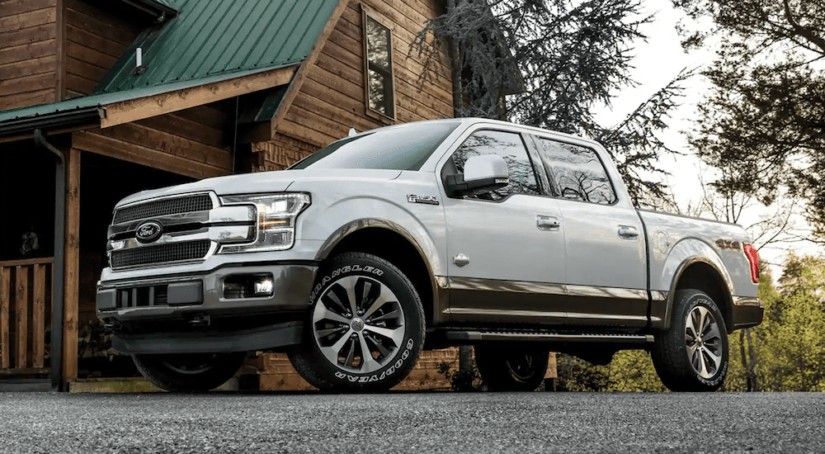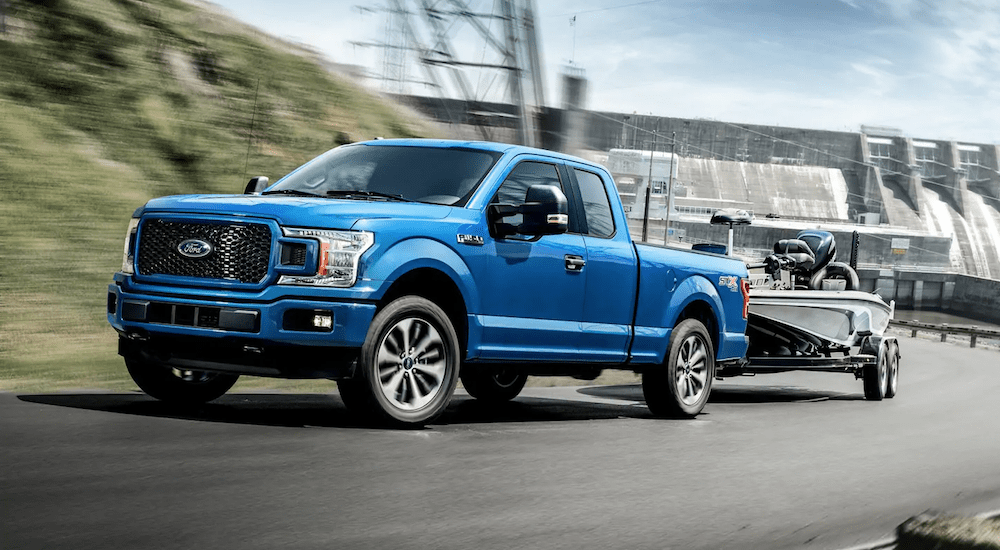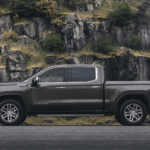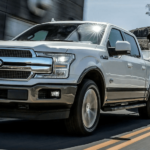If you’re like a lot of prospective truck buyers, you may have whittled your selection down to the 2019 Ford F-150 vs 2019 Toyota Tundra. It’s easy to see why. Both of these trucks have been big players in the 21st-Century truck battles. The F-150 is the undisputed sales leader and one of Ford’s most iconic models. The Tundra leads the pack of Japanese trucks by a large margin and adds a domestic flavor by being built in San Antonio, Texas. Although there are hundreds of features to consider when shopping for a truck, a lot of the final decision will come down to four main factors: power, fuel efficiency, technology, and price. We’ll take a look at the numbers to see which truck has the upper hand.
Setting the Stage
While nothing can match America’s current thirst for SUVs of all sizes, the current pickup truck boom is pretty close. In 2018, US pickup sales had already passed the 2-million-unit mark by September. All totaled, 2018 sales should finish a full 2 percent above 2017 numbers. Put it all together, and nearly 1/5 (18%) of light vehicles sold in the US come with an open bed. There are currently 11 models and seven brands to choose from, with Ford and Jeep adding two more models to the list later this year. While the collection may be intimidating, the intense competition between brands has put trucks at the leading edge of technology, efficiency, and capability – all to the benefit of the buyer.
The Ford F-Series has been around the block a few times – these trucks have been roaming the streets since 1948. The 2015 full redesign represents the 13th generation of F-Series pickups. The F-150 offers 3 cab selections with different bed options:
- Regular cab (two-door) with 5.5-, 6.5- or 8-foot bed
- SuperCab (double cab) with 5.5-, 6.5- or 8-foot bed
- SuperCrew with 5.5- or 6.5-foot bed
The F-150 can seat three, five, or six depending on cab and trim selection. As mentioned before, the F-series pickups truly are Ford’s cash cows. Sales have surpassed 500,000 units in every year since 1997, with the lone exception being about 400,000 units in 2009.
The Tundra got a late start in the full-size pickup market when it debuted in 1999 as a 2000 model. Since then, it has gone through two full redesigns, with the last coming in 2014. The Tundra offers two cab options and three different bed lengths:
- Double cab with 5.5-, 6.5- or 8.1-foot options
- Crew cab with 5.5- and 6.5-foot options
The Tundra can seat five or six passengers, with the base SR and SR5 offering first and second row bench seating. Although not the sales leader that the F-150 is, the Tundra has sold well and has surpassed 100,000 units every year since 2012.
Power
The F-150 comes with five engine choices, with the advanced EcoBoost engines powering the majority of F-150s on the road today. All engines are equipped with automatic start/stop technology, which turns the engine off when stopped at a red light. Prospective F-150 customers can choose from the following:
- 2.7-liter V6 – 325 horsepower (EcoBoost)
- 3.3-liter V6 – 290 horsepower
- 3.5-liter V6 – 375 horsepower (EcoBoost)
- 5.0-liter V8 – 395 horsepower
- 3.0-liter Turbo Diesel – 250 horsepower*
The 3.5-liter V6 will tow 13,200 pounds with the add-on max trailer tow package. The Diesel engine will tow a class-leading 11,400 pounds. Payload differs between trims and bed lengths from 1,326 pounds to 2,309 pounds. Any blog on the F-150 would be incomplete without a mention of the formidable Raptor. Available only with the 5.5-foot bed, the Raptor is an off-road savant built to conquer sand dunes and rocky wooded trails alike. Using an altered version of the 3.5-liter V6, the Raptor puts 450 horsepower to good use.
In the Tundra, it’s V8 or bust. Despite only offering one engine type, the Toyota does come with 2 different V8s and traction systems to choose from:
- 4.6-liter V8 (2WD) – 310 horsepower
- 4.6-liter V8 (4WD) – 310 horsepower
- 5.7-liter V8 (2WD) – 381 horsepower
- 5.7-liter V8 (4WD) – 381 horsepower
It’s no surprise that the 5.7-liter V8 leads the pack when it comes to towing, at 10,200 pounds. Payload stays remarkably consistent between powertrains, with all engine combinations hovering in the 1,600-pound range.
By virtue of its 5 different engine choices, higher towing capacity, and superior payload, the F-150 wins this one.
Fuel Efficiency
The best engine for fuel economy in the F-150 lineup is the 2.7-liter V6, which hits 20 highway and 25 city miles per gallon. The secret behind the EcoBoost engines is a combination of direct injection and turbocharging that increases power and performance without impacting fuel economy. In the F-150, this means that the V6 drives like a V8 while retaining the fuel efficiency of the smaller engine. The diesel gets a remarkable 22 highway and 30 city miles per gallon.
The Tundra’s fuel economy lags a bit behind the F-150. With the smaller V8, customers should expect to see 15 miles per gallon city and 19 mpg highway. For the 5.7-liter V8, those numbers drop to 13 and 18, respectively. This round clearly goes to the F-150.
Technology
Inside, both of these vehicles reflect the top technology available when their redesigns were completed. The F-150 and Tundra each feature a full-color information screen in the middle of the dash. Both trucks also come with blind spot detection, pre-collision alert, and a full suite of high-tech safety features. Two technologies really set the F-150 apart, however. It starts with the 360-degree camera that, when splitting the screen with the traditional backup camera, provides a better view of tight spaces and towing situations. The Trailer backup assist system makes reversing with a trailer a breeze. Instead of navigating two objects that move in opposite directions, simply turn the trailer knob in the correct direction and let the truck take care of the rest.
Although these two trucks both offer great technology, the F-150 simply offers more than the Tundra.
Price and Warranty
For starting price, the F-150 probably benefits from offering a regular cab model, which starts at a hair over $28,000. The Tundra SR double cab is offered for $31,420. A top-of-the-line F-150 Limited comes in at around $72,000. A Tundra Platinum with all of the boxes checked will ring in at around $52,000. The relatively large disparity between these two vehicles makes it hard to judge this round. While the F-150 Limited is on-par with some of the world’s best cars, the Tundra should earn some marks for remaining relatively cheap at a time when truck prices are soaring. On price, it’s a draw.
When it comes to warranties, both vehicles offer the same packages. New Tundra and F-150 owners would get 3 years/36,000 miles basic and 5 years/60,000 miles powertrain.
The Results
We don’t necessarily believe that it is up to us to push you towards either truck. Both are quality vehicles made by respected manufacturers. Both of these vehicles are highly capable and would make a great addition to any driveway. What was covered in this blog is by no means the exhaustive list of standard or available features for either vehicle. However, based on the facts and figures examined here, the Ford F-150 is the better truck. Its combination of power, fuel efficiency, technology and price make it the clear winner.
*Only available on Lariat, King Ranch and Platinum trims.




